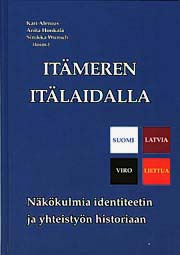|
Studia
Historica Septentrionalia 48 |
|
|
Kari Alenius, Anita Honkala
& Sinikka Wunsch (toim.),
Itämeren itälaidalla.
Näkökulmia identiteetin ja
yhteistyön historiaan.
Pohjois-Suomen Historiallinen
Yhdistys, Rovaniemi 2006, 206 pages
|
 |
Summary:
Sinikka Wunsch, “Finland is not a Baltic State!”. The Baltic
States in the Finnish newspapers in summer 1939 and 1940.
Itämeren itälaidalla. Studia Hisrtorica Septenrionalia 48 (2006),
45–60.
This article discusses the international
standing of the Baltic States in the Finnish newspapers mainly in
summer and autumn 1939 and during the so called Interim Peace in
summer 1940.
During the first period the politic
situation in Europe is advancing towards a war, which outbreaks on the
3rd of September. During the second the Great War is in progress and
Finland has been at war with the Soviet Union in winter 1939–40.
During the summer 1940 it was not yet known as the Winter War.
After the Munich Crisis of 1938 the
weakening of the Soviet Union was greeted with pleasure in Finland.
The press evaluated the threat of the Soviet Union to Finland and the
Baltic States decreasing.
The real concern for the situation of the
Baltic States emerged in newspapers in the beginning of June 1939. The
foreign minister of the Soviet Union Vjatšeslav Molotov insisted on
the Soviet Union the right to guarantee the safety of three Baltic
States. The real sensation in Finland aroused when he made known that
those three were Finland, Estonia and Latvia.
The Finnish press was outraged; Finland
was not a Baltic but a Scandinavian state. The reason for the
unanimous reaction of the press was based on concern for national
security. Finland, of course, wanted to be a part of the less
threatened Scandinavia instead of endangered Baltic. By this on the
famous unanimity of the Winter War was on its way. The press gave all
support to the politics of the Finnish government when opposing
uncompromisingly the opinion of the Soviet Union about Finland as one
of the Baltic States.
During the Interim Peace times of crisis
still continued in summer 1940. Articles dealing with foreign states
and foreign policy were censored, especially those dealing with the
Soviet Union, Germany and Sweden.
Events in the Baltic were much more
dramatic than a year before. The Soviet Union occupied Estonia, Latvia
and Lithuania from June 14, to June 17. Yet, the tone of discussion
among the printed media, concerning the acts of the Soviet Union, was
much less critical because of censorship. As a whole the tone was
defined by Finland’s own security in both summers.
In summer 1940 atmosphere in Finland was
strained because it was scared that the Soviet Union could attack on
Finland, too. Newspapers got the orders to handle events in the Baltic
extremely carefully. That is why there were only few editorials about
the subject during the whole summer. Those published condemned the
occupations, anyway.
At this hour the Finnish press begun to
follow the government’s orders also voluntarily, when the safety of
Finland was at stake. After the Continuation War (1941–1944) the so
called “self censorship” when dealing with the Soviet Union, become
normal practice among the Finnish press. It remained as such until the
collapse of the Soviet State in the early 1990’s.
Studia Historica Septentrionalia 48
|